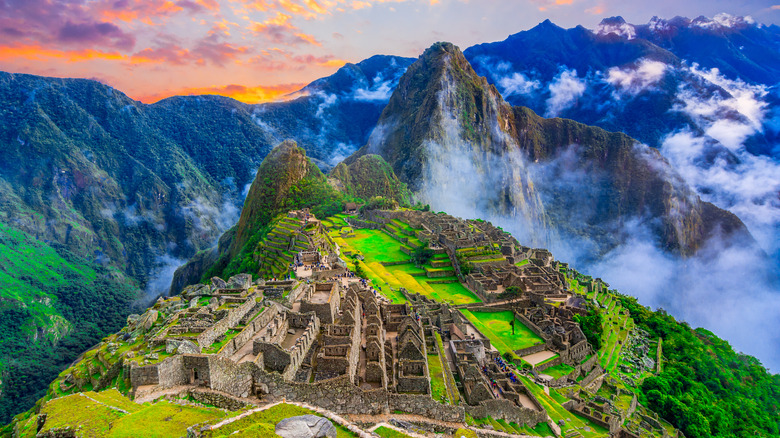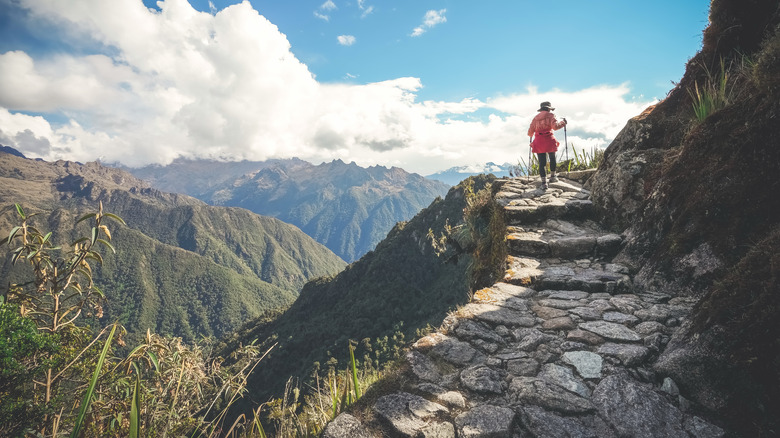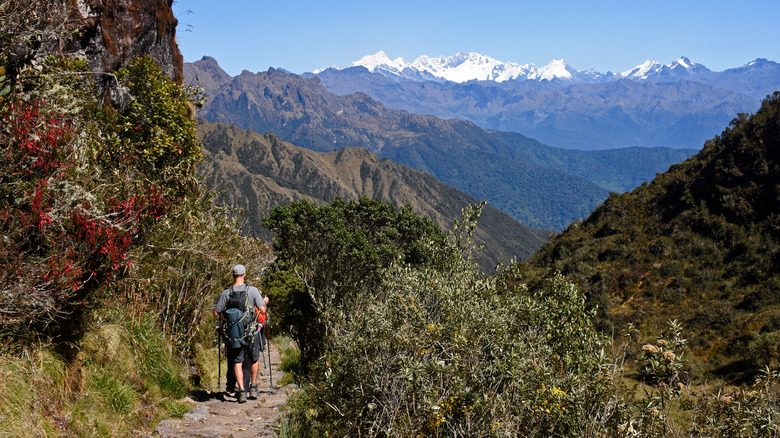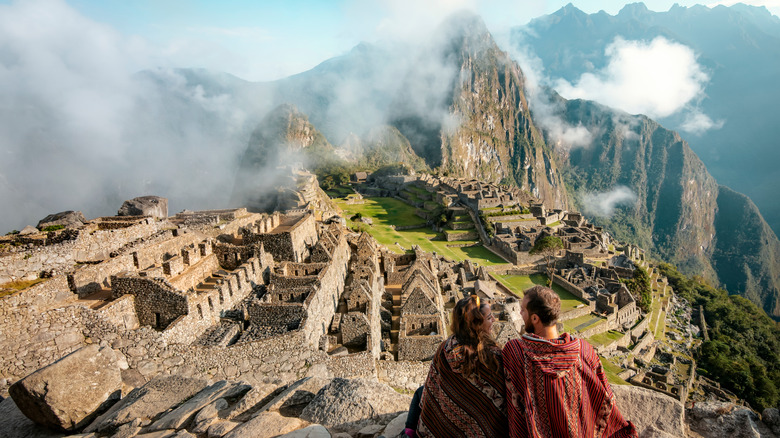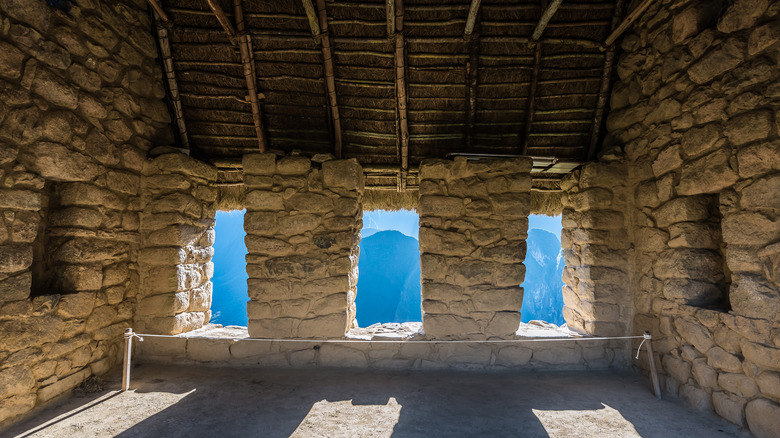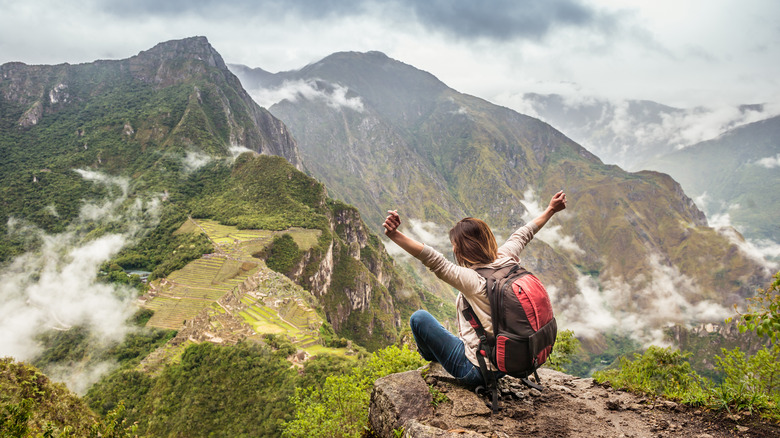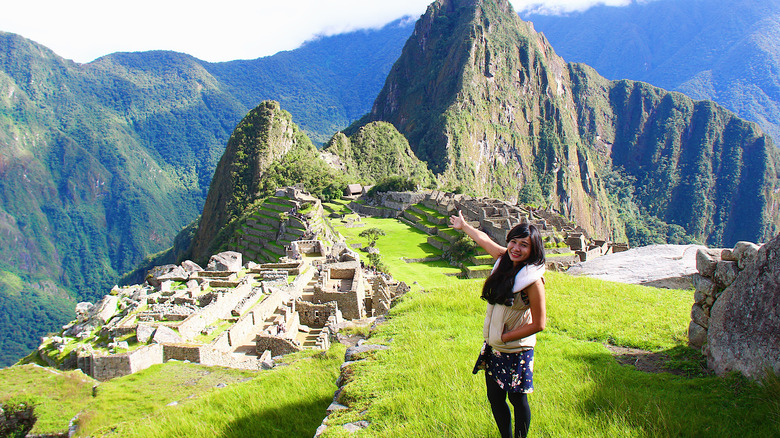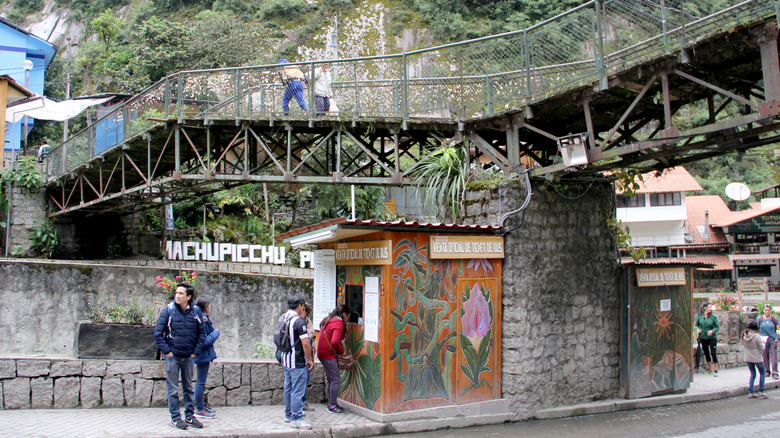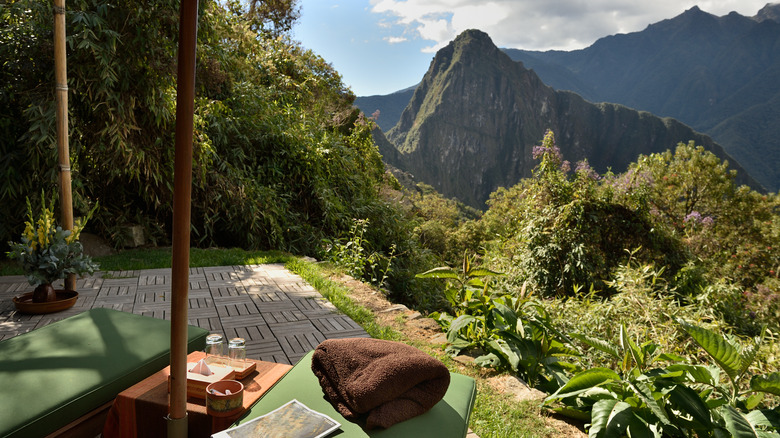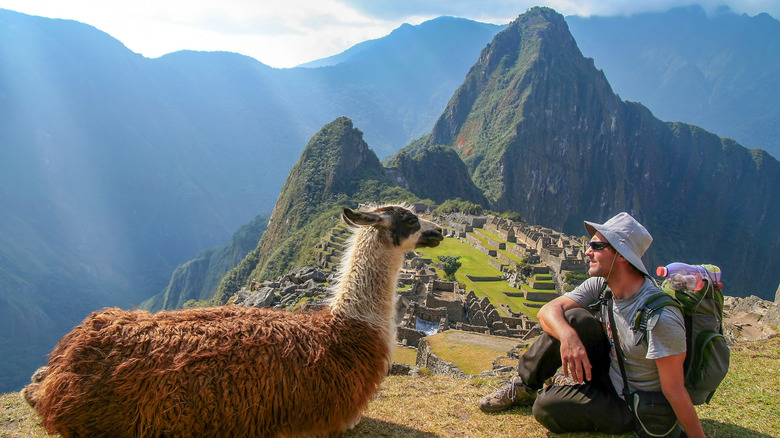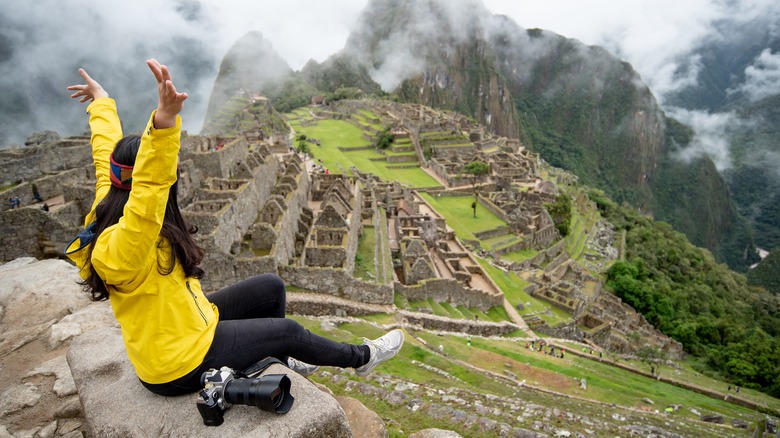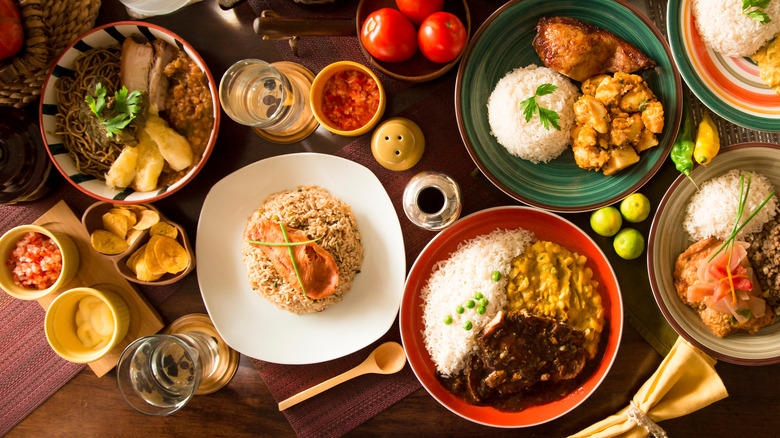All Of Your Questions About Traveling To Machu Picchu Answered
We may receive a commission on purchases made from links.
Steeped in history and breathtakingly beautiful, Machu Picchu is the ultimate bucket list travel destination. Unknown except to the locals until an American archeologist stumbled upon it in 1911, the majestic ruins of this 15th-century Inca citadel nestled in the Peruvian countryside were named a UNESCO World Heritage site in 1983.
Today, the site ranks among the seven wonders of the world, and more than 2 million eager visitors flock to it each year to soak up its magic and mystery (via Machu Picchu). Before you go packing your bags, though, there's a lot of research that goes into planning the perfect once-in-a-lifetime Machu Picchu adventure. From what to see, where to stay, what to eat, what to pack (and what not to pack), to knowing how to keep yourself from getting waylaid by the effects of altitude sickness, here's everything you need to know before you go to Machu Picchu.
How do I get to Machu Picchu?
Nestled in the Peruvian countryside in the Cordillera de Vilcabamba of the Andes Mountains, Machu Picchu cannot be directly accessed by private car (via Cachi Life). To get there, you first need to get to Cusco, a medium-sized city located about 50 miles southeast of the ruins. From Cusco, you can take a train or hike there. Most people will opt for train travel, but if you're keen to test your trekking skills, skip to the next section.
The railway winds through the Andes Mountains and the Sacred Valley, so this will likely be one of the most scenic train rides you'll ever take (via Peru for Less). The train is not just transportation, but rather part of the entire experience. Two railway operators — PeruRail and Inca Rail — provide service between Cusco and the small town of Aguas Calientes, also called Machu Picchu Pueblo. The trains offer modern cars with a wide variety of departure times and different levels of service, from budget to first class. Depending on which station you depart from, the trip to Aguas Calientes takes about 3.5 to 4.5 hours. From there, Machu Picchu is just a short shuttle bus ride away.
Can I trek to Machu Picchu?
For the active traveler, there is no better way to get to Machu Picchu than on foot via the classic Inca Trail, which is the same route the Incas traveled to get to Machu Picchu many centuries ago (via Machu Travel Peru). Stretching 26 miles through mountains and subtropical jungle, the distance typically takes four days and three nights to cover. You must hire a guide who will secure your permit to hike the trail, as all foot traffic is regulated by the municipality and only a certain number of people are allowed to hike the trail each day.
The trek is not an easy one, so you should ensure you have an adequate fitness level. The trail is a mix of dirt and paving stones and features thousands of steps, which can be tough on the knees. Be prepared for steep ascents, including Dead Woman's Pass at 13,828 feet. You'll also need to be prepared for the elevation gain, which can increase the physical challenge due to lower amounts of oxygen at higher altitudes. This is a trek you should begin preparing for at home several months in advance.
Accommodations along the route are rustic with designated campsites. Your trekking company has pre-assigned sites, and camping outside of these sites is not allowed (via AB Expeditions). Each campsite has restrooms, but no showers; however you will be provided with water for washing up. In some cases, tour companies may provide portable showers for an additional cost.
What's the best time to visit Machu Picchu?
The best time to visit Machu Picchu depends on the individual and whether you prefer good weather or fewer crowds. Like other popular tourist destinations, Machu Picchu has a high and a low season. The high, or peak, season runs from June to September (via Go Andes). This is when many children have summer vacation, and the destination draws in a large number of families. This also coincides with the dry season, which starts in April and ends in November. During this period, the weather is temperate and dry for trekking and offers clear views of the mountain peaks (via Rickshaw Travel). Because of these prime conditions, you can expect longer lines, bigger crow, and higher ticket prices (via Ticket Machu Picchu).
The low season is from November to April. The weather from December to March can be quite wet with heavy downpours and fog obscuring the views. Temperatures can fall quickly at night and at higher altitudes. However, this means there may be far fewer tourists to compete with for lodging, tours, and views. You may also find lower prices during these times.
If you are planning to trek to the ruins, it can still be done in the low season; however, keep in mind that the Inca trail is closed for maintenance in February. During this time, the only way to get to the ruins is by train and shuttle bus.
What are some top sights to see?
The citadel contains 200 sites (via UNESCO). These include plazas, fountains, archaeological complexes, temples, monuments, and residences (via Peru). The Guardian's House is one of the most popular spots — and for good reason. It's the best point from which to snap those perfect postcard pics with the ancient city spread out behind you. Located on the upper level of the ruins in what was once the agricultural sector, the modest stone house with a thatch roof served as a guard post for the ancient city.
More stunning vistas of the whole of Machu Picchu can be seen from the Sun Gate (or Intipunku in the native Quechua language), which was originally the main entrance to the citadel (via Andean Trails). If you are trekking to the ruins, this is the gate through which you will enter.
Located in the Sacred Plaza, the Principle Temple is a large three-sided building crafted out of stone and showcasing the skill of ancient Incan masons (via South American Vacations). This building hosted important ceremonies to honor the Sun God and the mountains, and its trapezoidal niches were used to place offerings.
The Temple of the Sun is the only round building in Machu Picchu (via Ticket Machu Picchu). As its name implies, this religious edifice was built as a place to worship the sun. The structure also served as an observatory from which to monitor the solstices and seasonal changes.
Can I hike at Machu Picchu?
Even if you don't make the trek up to Machu Picchu, you can still enjoy the natural surroundings on some beautiful hikes throughout the area. The diamond-shaped peak of Huayna Picchu is unmistakable, rising up behind the ancient citadel. The trek to the top is 2.5 miles and takes about two hours, gaining 1,000 feet in elevation (via Machu Travel Peru). It's a moderate to difficult hike with a steep ascent that will transport you to breathtaking vistas over Machu Picchu, the surrounding valley, and the Salkantay glacier off in the distance (via The Explorer's Passage). Hiking is only allowed in shifts, during which a certain number of people are allowed to make the ascent.
Another popular choice is the hike to the top of Machu Picchu mountain, which rises 10,000 feet to the southwest of the citadel. This is a more strenuous trek, ascending 2,139 feet up an old Incan stone trail to the summit, a former religious site where Incan priests performed rituals. The trip takes about three hours round trip, and only 400 hikers are allowed to enter each day (via The Only Peru Guide).
If you can afford to make the time investment, the five-day trek to Salkantay is worth every minute (via The Explorer's Passage). Traversing through some of the most picturesque landscapes in the Sacred Valley, you'll ascend the Salkantay Pass at 15,090 feet, then descend through rainforest and meadowlands. You can also access Machu Picchu via this route (per Salkantay).
Do I need a tour guide?
As of 2017, visitors are required to hire a guide to tour the ancient archeological site (via Ticket Machu Picchu). You can hire a guide in advance online or directly at the entrance to the site. With either a private guide or in a group tour, you can choose from three different tour options that vary in distance and difficulty. According to the site, the longest option takes about three hours and includes these sites: Guardian's House, Main Square, Temple of the Sun, Botanical Garden, Intihuatana, Sacred Rock, Temple of the Three Windows, Temple of the Condor, Colcas, and the water mirrors. The most popular option, circuit two, takes about 2. 5 hours and visits all of the same sites, except for the Guardian's House. The last option is the shortest circuit, lasting two hours, which includes a visit to the Colcas, Temple of the Sun, Botanical Garden, Main Square, Temple of the Condor, and water mirrors. This is the best route for older adults and people with disabilities.
The price for the tours vary depending on whether you choose a private guide or join a group tour. Tours are frequently offered in Spanish, English, and Portuguese. To be guaranteed a guide in a specific language, it's best to book ahead of time through a tour agency online.
How do I buy tickets?
Only 2,500 people are allowed to enter the Machu Picchu archeological site each day (via Go Ahead Tours). Therefore, it's important to buy your tickets ahead of time, especially during the high season. Although it's possible to buy tickets in Cusco or in Aguas Calientes on the day of your visit, you risk that they will be sold out and you will not be able to enter the site. Buying your tickets online is your best option. You can do so directly through the Peruvian government website, or you can book through any number of travel and tourism websites. Note that your ticket is separate from your tour guide booking. If you book a guided tour through an agency in advance of your visit, your tickets may or may not be included in your tour package, so it is best to confirm.
Ticket prices vary depending on the type of ticket you book and whether you book through a travel or tour agency. When booking through Cusco's official tourism agency, you have a choice between several types of tickets (via Machu Picchu). You can buy just the entrance to the archeological ruins, or you can add on the treks to Huayna Picchu, Machu Picchu mountain, the Inca Bridge, or a combination. At the time of writing, ticket prices for visitors are $60 for adults or $35 for students under the age of 18.
Where should I stay?
From hostels to five-star hotels, you have plenty of choices when it comes to lodging during your Machu Picchu adventure. The stunning Relais & Chateaux resort Sol y Luna will appeal to those who appreciate the best of everything. Cradled in the Sacred Valley, it features abundant gardens, a spa, a pool, two top-tier restaurants, and horse stables. Another luxe pick in the Sacred Valley is the Explora Lodge, an exquisitely designed architectural beauty that incorporates Incan remains into its decor.
If mid-range is more your speed, the four-star Casa del Sol is sure to please with its own spa, well-rated restaurant, and a mix of modern and traditional decor. Each of the hotel's rooms features a private bathroom, satellite TV, and a minibar. Another solid mid-range option, the three-star Tierra Viva Machu Picchu Hotel, is just a short trek to Machu Picchu. Its comfy rooms are quiet and cool with air conditioning, cable TV, minibars, and private baths. The terrace offers views upon views of the surrounding mountains.
For those looking to explore the ancient citadel without breaking the bank, the Terrazas del Inca Bed and Breakfast is a small, riverfront three-star hotel with a cafe serving free breakfast, a bar/lounge for a perfect post-ruins cocktail, and a relaxing terrace and garden. Travelers rave about the hot springs-adjacent location and the friendly staff. The highly-rated Supertramp Hostel offers affordable private and bunk accommodations with eclectic decor, an onsite restaurant, terrace, shared lounge, game room, free Wi-Fi throughout, tours, and nightly entertainment.
What about altitude sickness?
Machu Picchu is at 8,000 feet elevation and Cusco is at 11,150 feet elevation. Traveling at this altitude requires special preparation and precaution, especially if you plan to undertake strenuous physical activity, such as trekking up the mountain. According to the Centers for Disease Control and Prevention, the lower oxygen levels at elevations over 8,000 feet can cause altitude sickness, symptoms of which include dizziness, lightheadedness, headache, nausea, fatigue, and lack of appetite. Although it's not possible to completely avoid altitude sickness, you can reduce your risk of symptoms by avoiding alcohol and strenuous activity during your first 48 hours at higher elevations, getting plenty of sleep, and staying hydrated.
If you plan to hike at Machu Picchu, Intrepid suggests spending a few days acclimatizing in Cusco before starting, getting plenty of rest in the few days before your trek, avoiding drinking alcohol during your trek, and drinking at least half a liter of water for every hour of trekking. You can help increase your blood oxygen levels by taking long, slow inhales and exhales every so often, and you can carry special medication for altitude sickness with you as a precaution.
What should I pack?
What you pack for your epic voyage to Machu Picchu depends on your travel plans. If you're riding the train to wander around the ruins for a few hours and then headed back to your hotel, your packing list will be a lot less complex than if you're trekking. No matter the season, wet or dry, you should be prepared to protect yourself against rapidly changing weather, warm and cool temperatures, sun, wind, rain, and insects (via The Real World). Even when it's hot, breathable long sleeves and pants are a good idea. In the rainy season, you will definitely want to pack a waterproof layer. Sunscreen, insect repellent, and good walking shoes are a must. Even if you're not trekking, the terrain is varied and often uneven, so be mindful of your shoe choice. Bring a daypack along with some layers, snacks, a camera, a refillable water bottle, and any medications you may need.
If you're trekking, your tour company should provide you with a list of items to bring. In many cases, the guide will provide all the gear you need, such as tents, sleeping bags, etc.; however, you will still need a pack large enough to carry clothes and other essentials adequate for the duration of your trek (via Viator). Temperatures can drop quickly at night, so extra layers are key.
What kind of food will there be?
Traditional Peruvian food centers around rice, chicken, pork, potatoes, and lamb (via Machu Picchu). Fish is also very popular and widely offered. Peruvian cuisine often features different types of hot pepper, or "aji," including yellow, red, and red rocoto. Famous Peruvian dishes include ceviche, which consists of a variety of seafood cured in lemon juice and mixed with onions and spices. Comida Criolla are traditional Peruvian stews with fish, meat, and vegetables. With such a wide range of flavors and preparations, there is a little something for every traveler, no matter their tastes.
However, you'll also find plenty of International food options, too, including everything from burgers to pizza, vegan food, Chinese, Spanish, and French. For some good old comfort food, head to Jack's Cafe in Cusco for classics such as BLTs, tuna melts, and French toast. You'll find the most authentic pizza at Cusco's Carpe Diem, featuring a chewy, crispy crust made from dough fermented for 24 hours. And if you just can't live without French pastry, you're in luck in Aguas Calientes, as it's home to La Boulangerie de Paris, where everything from scones and croissants to croque monsieurs are made on-site and from scratch.
